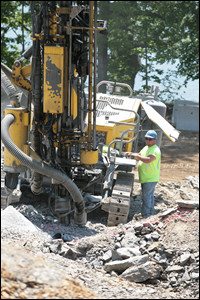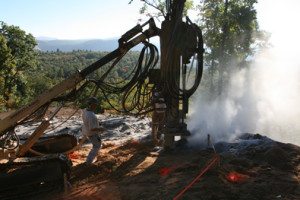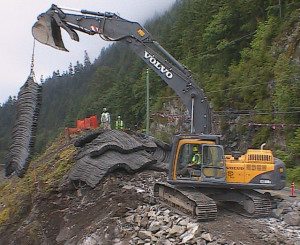Remote and rural locations are picture perfect for Katahdin Cedar Log Homes. But undeveloped sites often carry  additional challenges not found when building in a development. Last month we talked about private roads and culverts, today we review blasting.
additional challenges not found when building in a development. Last month we talked about private roads and culverts, today we review blasting.
Most people have little or no experience with blasting for home construction, and the possibility of blasting may lead a land buyer to reject a prime parcel of land for fear of high costs or danger. However, with some smart planning and an experienced contracting crew, blasting need not be a big deal. In fact, the rural location provides some immediate positives by eliminating the need for numerous pre-blast preparations required in more populous areas.
We spoke with Ken Smith, Technical Supervisor for Maine Drilling and Blasting, to get some insights on how blasting works. “Blasting in New England and elsewhere happens much more frequently than many people realize,” explained Smith. “Our safety procedures and strict regulations keep the process safe and controlled.” He shared how the blasting process works from detection and pricing to final blasting.
First Steps on a Building Site
When walking the land on a potential building site, keep an eye out for any exposed rock. In Maine we have a lot of it, and most of it is some form of granite. Other areas may have rocky ledge that is more crumbly and could be removed by an excavator. One source to examine when considering a rural parcel for a log home is US Geological survey data for the  region, which may provide some historical information on geologic areas.
region, which may provide some historical information on geologic areas.
One old farmer’s trick Smith shared is to take a heavy iron pry rod and sharply strike the exposed rock formation with it. If the rock is a boulder, the iron rod strike will make the rock feel like it is vibrating below the feet. It the iron bar doesn’t produce this sensation, it is likely a larger, intact ledge that will require blasting. “You can get a detached ledge that will hum, but usually the boulder is small enough to remove with a piece of heavy equipment,” said Smith.
Unfortunately, much of the time a ledge formation is buried under soil and only an excavator will expose the amount of rock on a parcel. If it appears that there might be ledge or rocky areas, based on experience in the area or exposed rock, there are some steps a homeowner can take in advance of starting construction to get a better handle on the costs and expertise needed.
How Big a Hole?
When researching the potential cost for blasting, the first factor is how much material will need to be removed. Having a home plan in hand can assist greatly in calculating the size of the excavation. Another consideration is any other trenching on the site for underground utilities, drainage, swimming pools or other excavation areas.
 Price is generally not affected by the depth of the hole, Smith noted. “Whether it’s two feet or eight feet, the blasting company will need to drill deep enough to hold the charge. Also, getting the drilling and blasting equipment to the site will have the same mobilization cost no matter the size of the hole,” he explained. The cost for blasting should be in line with other big ticket infrastructure items. In New England, an average blasting job for a home might be $20,000-$25,000, depending on the location and circumstances. For trenching, a blasting company should be able to provide a linear, cost-per-foot estimate.
Price is generally not affected by the depth of the hole, Smith noted. “Whether it’s two feet or eight feet, the blasting company will need to drill deep enough to hold the charge. Also, getting the drilling and blasting equipment to the site will have the same mobilization cost no matter the size of the hole,” he explained. The cost for blasting should be in line with other big ticket infrastructure items. In New England, an average blasting job for a home might be $20,000-$25,000, depending on the location and circumstances. For trenching, a blasting company should be able to provide a linear, cost-per-foot estimate.
How Does a Blasting Project Progress?
Smith explained that many blasting companies work as subcontractors to the excavation contractor. The excavation contractor will use his heavy equipment to dig out and expose the areas of ledge that might need blasting in the course of preparations for the basement or foundation. The excavation company would also be working on any trenching and can delineate those areas where blasting might be required. Smith said that it is essential that the excavating company have experience in coordinating with a drilling and blasting company so that the right heavy equipment will be on hand. Especially important is the ability to lift and place a blasting mat if required. Blasting mats are made from recycled tires woven together with steel cables into a thick pad weighing as much as 10,000 pounds.
Once the area is cleared and prepared, the blasting company will bring in the drill, which is maneuvered on crawler tracks once it is unloaded from the transport truck. The drill will be positioned to drill the holes in the rock into which the explosives are placed. They will need to be deep enough to accommodate the explosives and then filled with material to contain and direct the explosion into the rock. Many blasting companies employ CAD programs to help design a blasting project, especially if the size of the hole is particularly expansive. Actual drilling may take as little as a half day to as many 2 or more days depending on the configuration and size of the blasting.
Once all the holes are drilled, the explosives team will place the charges and set up the firing sequence. Smith indicated that rural sites without a lot of neighboring structures are the easiest to complete, especially if flying stone is not a worry. In closer confines, the large blast mats will be used to contain the explosion and minimize flying debris.
Another aspect of blasting and excavation coordination is what Smith called “balancing the project.” This involves identifying areas where the material removed by blasting might be re-purposed elsewhere on the site to save in costs for dirt fill or other materials. If the blasting project is large enough, it may make economic sense to bring in a rock crushing machine to take blasting product and reduce it to a form that could be used as a road bed or other application on-site. This might be an important element if the site is particularly remote from sources of gravel or fill.
Getting Estimates
As with any subcontractor, it’s important to conduct the research into a blasting company up front. Blasting companies are licensed and regulated by states, and in some areas, individual blast technicians may be licensed as well. A word of caution in comparing prices for blast work, says Smith. A very low price estimate may indicate a company that is less desirable and ultimately may cost more if the project is not well planned and coordinated. Again, a good resource for blasting companies is the excavation contractor, who will know which company is best prepared to handle the job.
Ultimately, if your building plans include the potential of blasting, you shouldn’t be frightened away. Just budget for it and make sure your contractors are experienced in coordinating the blasting work.
